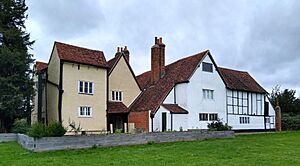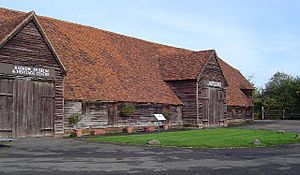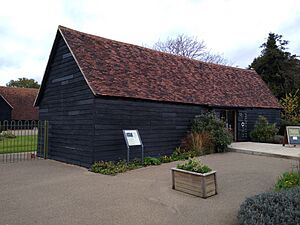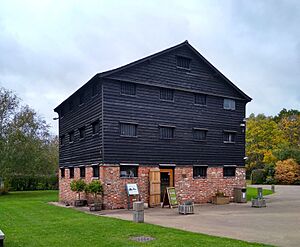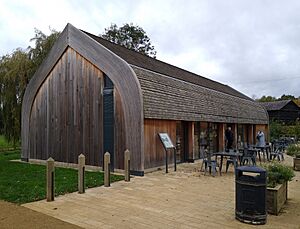Headstone Manor and Museum facts for kids
The Headstone Museum, also known as the Harrow Museum, is a cool place to learn about local history in London Borough of Harrow, England. It's like a time capsule that tells the story of Harrow through its amazing collections and old buildings.
Contents
Discovering Headstone Museum
The museum opened its doors in 1986. It's located on the historic grounds of Headstone Manor. Records show that this land has been important since 825 AD! All the buildings here are very special and protected. They help tell the story of Harrow, its people, and the area around it.
Amazing Old Buildings
Headstone Manor House
The Headstone Manor house was built around 1310. It's the oldest timber-framed building still standing in Middlesex. Imagine, it's over 700 years old! Experts say it's one of the most interesting old houses in the whole country. You can see parts of the building that were built in the 14th, 17th, and 18th centuries. It's a very important building, listed as Grade I.
The manor house is surrounded by a moat that's still filled with water. This moat was built at the same time as the house. It was a way for the owner to show off their wealth and importance.
The land where Headstone Manor stands belonged to Wulfred, who was the Archbishop of Canterbury, way back in 825 AD. Building the manor house started around 1310. We know this because scientists checked the age of the old wooden beams. Later, in 1344, John de Stratford, another Archbishop of Canterbury, bought more land. He used Headstone Manor as his main home in Middlesex. The Archbishops of Canterbury owned the manor until 1546. Then, Henry VIII took it over. Soon after, King Henry VIII sold it to one of his friends, Edward North. The manor stayed in private hands for nearly 400 years.
Over the years, many owners added to and changed the house. They built extra wings and updated the inside and outside. For example, the great hall got new wooden panels in 1631. In the 1770s, a stylish brick front was added. This is how Headstone Manor looks today.
Eventually, Headstone Manor started to fall apart. Much of its land was sold off. In 1925, the local council bought the site. Later, the London Borough of Harrow took control. After many years of decay, it was decided to turn the site into the Harrow Museum. The museum officially opened in 1986. The first big repair work on the oldest parts of the building began in late 2004.
The Great Barn
Headstone Manor used to be a working farm. It had many old farm buildings around it. By the early 1900s, most of these buildings were in bad shape and were torn down. Only two remain. The most impressive one is the Great Barn.
The Great Barn was built in 1506. It was ordered by the Archbishop of Canterbury at that time. Its frame is made entirely from English Oak. It's huge, measuring 43 meters long and nine meters high! Originally, farmers used the barn to store grains and keep horses. A few sections were kept for the Archbishop's use. Even though it was sometimes called the Tithe Barn, it was never used to store tithes (a type of tax).
By the 1920s, the barn was in very poor condition. A major restoration project by the London Borough of Harrow in the 1970s brought it back to its former glory. The Great Barn was updated to be useful for an active museum. This beautiful brown wooden building with its old tiled roof became the first usable part of Harrow Museum when it opened in 1986.
In 2014, more restoration work began. The Great Barn was transformed into a space for events and gatherings.
The Small Barn
When people dug at the Small Barn site, they found pieces of pottery from prehistoric and Roman times. This shows that people lived here thousands of years ago! Digging also revealed that the Small Barn's foundations are from the 14th century. This means it's as old as the first parts of Headstone Manor house and its moat.
The Small Barn stands across from the huge Great Barn. It was originally two buildings standing end to end. Later, they were re-roofed as one, with a drain in the middle. It was probably used to keep farm animals. It's thought that several buildings have stood on this spot. Most of the wood you see today seems to be from the early 16th century, like the Great Barn.
In the mid-1970s, a fire almost destroyed the Small Barn. For 20 years, its burnt frame was covered by a protective plastic cover. Finally, it was restored. The Small Barn is a Grade II listed building. It re-opened in late 2017 with exhibitions about archaeology and a film.
The Granary
The Granary is a Grade II listed building. It's the only museum building that wasn't originally part of Headstone Manor's farm. It was first built about a mile away, at Pinner Park Farm. When it was no longer needed and started to fall apart, it was carefully repaired. Then, it was moved to the Harrow Museum site in 1991.
Built in the late 1700s, the Granary was actually used to store food for cattle. Even though it only has a ground floor and a first floor, it has a surprising number of windows on the upper level. This makes it a bit of a mystery! The building was originally longer. But one end stood in wet ground and rotted away. That's why the Granary is its current size today.
The Granary building fits in well with the rest of the Harrow Museum site. It opened to the public in 1992. After restoration work funded by the Heritage Lottery Fund, it re-opened as a learning space in late 2017.
Other Cool Stuff at the Museum
The Moat Café and Visitor Centre
Near the Small Barn, you'll find The Moat Café and Visitor Centre. Here, you can get fresh coffee, cakes, paninis, and other hot snacks. The Visitor Centre also has a gift shop. You can find handmade items, jewelry, books, and gifts for kids. It also has a disabled toilet and baby changing facilities. The Moat Café and Visitor Centre is open every day except Mondays.
Car Park
There's a free car park on Pinner View. It's about 100 meters from the museum's entrance gate.
Cycling
If you come by bike, there are several bike racks. You can find them near the car park and the Headstone Recreation entrances to the museum.
What's in the Collection?
As a local history museum, the Harrow Museum has over 15,000 objects! These items are all connected to the Harrow area. The collection shows the social and industrial past of Harrow and its people. It includes many items from the Eastman Kodak factory, the Whitefriars Glass factory, and the Hamilton paint factory. The museum also has a large collection of archaeological objects. These range from very old prehistoric items to things from the recent past.
See also
- Grade I and II* listed buildings in Harrow


